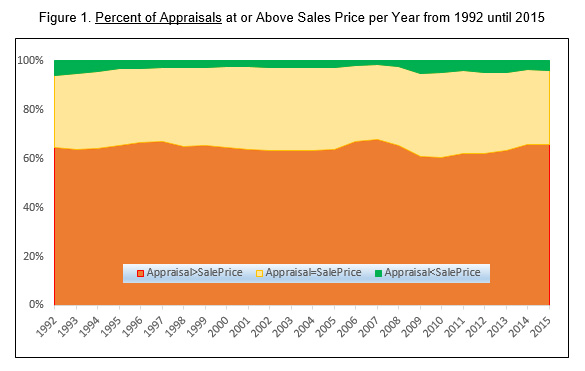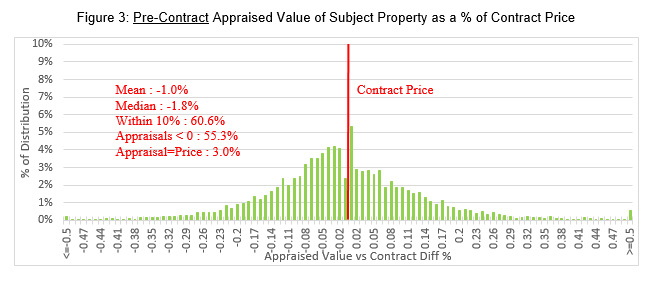Opportunities to Improve the Value of Appraisals

Consumers pay for a property appraisal as part of obtaining a mortgage to finance the purchase of a home. The goal of an appraisal is to provide an unbiased estimate of collateral value that will help creditors and secondary market investors more accurately measure the risk of the mortgage. However, given that more than 90 percent of appraisals value the home at the contract price or higher, it is not clear the extent to which appraisals provide a meaningful check on risk. Additionally, accurate appraisal values should alert borrowers to situations where they have overpaid – with appraisal values below contract price disrupting some deals but also offering homebuyers opportunities to renegotiate to lower prices.
This FM Commentary introduces two papers that consider the issues of appraisal integrity and borrower protection.
Appraisals Rarely Fail to Confirm the Transaction Price
For at least two decades, more than 90 percent of appraisals submitted to Fannie Mae have valued homes at or above purchase price as shown in Figure 1 below. For nearly a third of purchases, the appraisals valued properties at exactly the sale price.

Reforms following the 2008 housing crisis attempted to improve the independence and accuracy of appraisals, and some early research indicated these reforms were marginally successful, with the percent of transactions confirmed falling from a high of 98 percent in 2007 to 94 percent in 2009. Confirmation rates, however, have since drifted back up as we have moved further away from the financial crisis.
Practices Used to Confirm Contract Price
In the first paper, Contract Price Confirmation Bias: Evidence from Repeat Appraisals, written in collaboration with Dr. Michael Eriksen, Assistant Professor of Real Estate at the University of Cincinnati, we use a unique data set of residential properties that were appraised twice within 6 months between 2012 and 2015. The first appraisal for each property was done prior to the agreement of a contract price (pre-contract), while the second was done after the agreement and with the knowledge of a contract price agreed on between buyer and seller (post-contract). The following significant differences were found between the two appraisals:
- The two appraisers, though both inspecting the same unaltered subject properties at nearly the same time, disagreed with each other about the “condition” classification 40 percent of the time and the “quality” classification 44% of the time.
- Post-contract appraisals were more likely to select comparable sales of properties that were in superior condition and sold for average higher prices than pre-contract appraisals.
- Post-contract appraisals adjusted comparable values more positively than did pre-contract appraisals, particularly when comparable sales had average values below contract.
- Post-contract appraisals applied more weight to higher-valued comparable transactions if an average of all transactions used as comparables would have resulted in an appraised value less than contract price.
At every stage, post-contract appraisals showed non-symmetric moves toward the contract price or above it, resulting in values that exceed contract price 93 percent of the time for our post-contract sample as shown in Figure 2.

For pre-contract appraisals the selection of comparables, adjustments, and reconciliation generated distributions that were much more symmetrically distributed around the subsequent contract price as shown in Figure 3.

The differences in practices between the two appraisals resulted in the post-contract appraisal opinion of value being on average 4.2 percent higher than the pre-contract appraisal for the identical property, after controlling for differences in the local home price index between when the two appraisals were completed. Considering the average home price or its relationship to most buyer’s incomes, this is a noteworthy difference.
Lost Opportunity for Homebuyers to Renegotiate Purchase Price
Appraisals often cost $500 or more, typically paid for by loan applicants who need to prove their collateral is appropriate to support the contract price. This cost should result in an unbiased estimate of value for the borrower. In the second paper, Housing Market Effects of Appraising Below Contract, the authors show that when an appraisal comes in below contract, there is only a modest reduction in the probability of the loan being delayed or failing to close, a rise from the base rate of 25 percent to 32 percent. What happens instead is that the probability of the borrower renegotiating a lower price increases dramatically from 8 percent to 51 percent.
Thus, if appraised values mechanically confirm the contract price, they may deprive the borrower a chance to renegotiate the sale price. Presumably, most borrowers would want the opportunity to get the house for less, even at a small risk to the deal.
Improving the Appraisal Process
The major policy implication of this research is that further appraisal reform is required. Four suggested changes could enhance the informational value of the appraisal:
- Equal Weighting of Comparables – Require over-all symmetric weighting of high- and low-comparable properties in the final reconciliation step of the appraisal.
- Improved Definitions and Availability of Pictures from Prior Appraisals – Overhaul the appraisal data definitions (including pictures and more specific language) so that different appraisers who can both observe a property have reasonable consistency in categorizing qualitative attributes (quality, condition, view, location).
- Range of Value Instead of Point Estimate – Release appraisers from the unrealistic requirement to arrive at a single value and instead provide a value band within which a home might reasonably transact.
- Consider Not Providing Appraisers with the Contract Price – Consider whether not providing appraisers with the existing contract price as part of the appraisal process would help eliminate a necessary element for potential confirmation bias of the final appraised contract price.
Mark Palim
VP, Applied Economic and Housing Research
Economic & Strategic Research Group
Eric Rosenblatt
VP, Credit Risk Analytics and Modeling
Single-Family Mortgage Business
October 28, 2016
Opinions, analyses, estimates, forecasts and other views included in these materials should not be construed as indicating Fannie Mae's business prospects or expected results, are based on a number of assumptions, and are subject to change without notice. How this information affects Fannie Mae will depend on many factors. Although the authors base opinions, analyses, estimates, forecasts and other views on information it considers reliable, it does not guarantee that the information provided in these materials is accurate, current or suitable for any particular purpose. Changes in the assumptions or the information underlying these views could produce materially different results. The analyses, opinions, estimates, forecasts and other views published by the authors represent the views of that group as of the date indicated and do not necessarily represent the views of Fannie Mae or its management.
